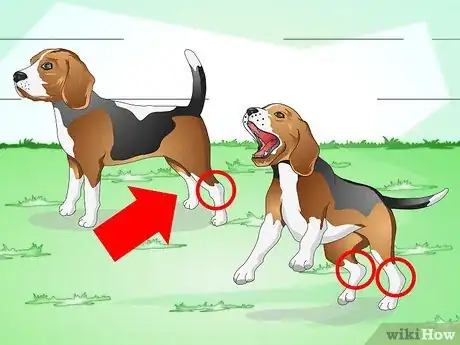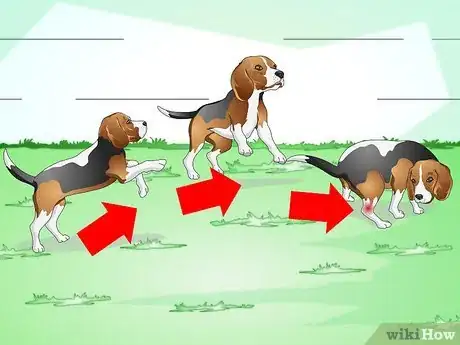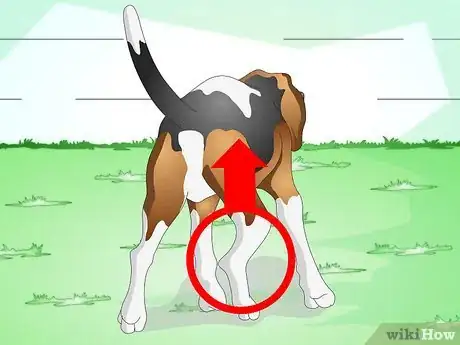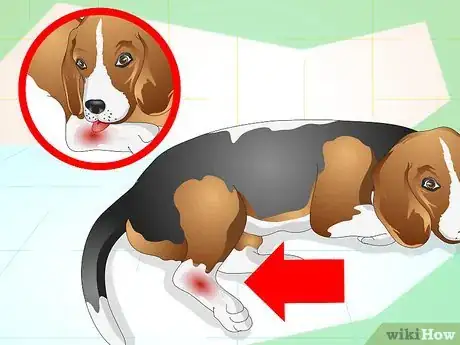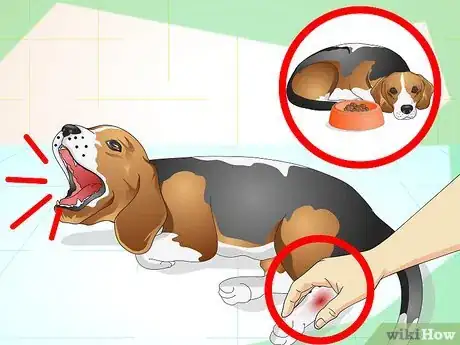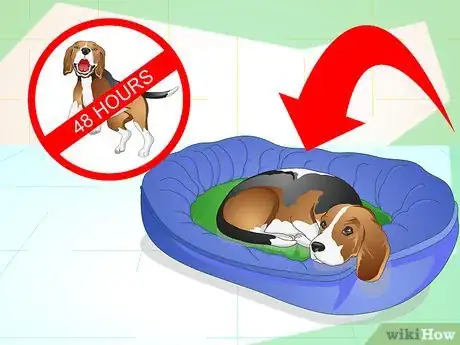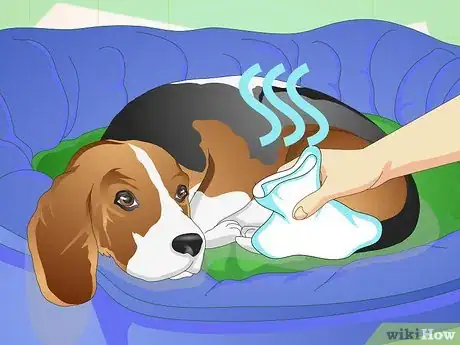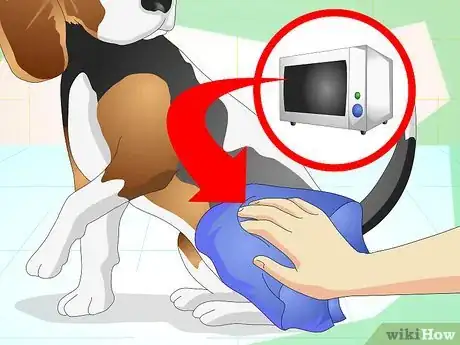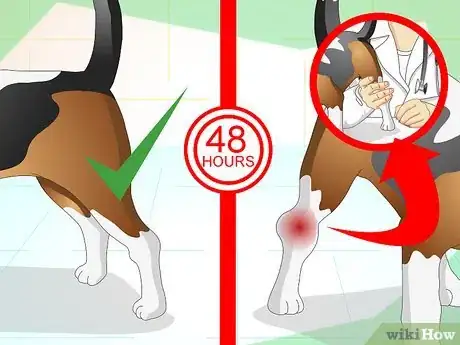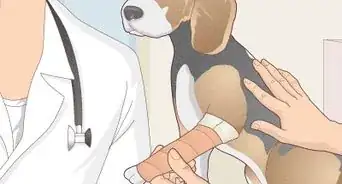This article was co-authored by Natalie Punt, DVM. Dr. Natalie Punt is a Veterinarian and the Founder and CEO of mPet- a smart phone app for pet owners to store, manage and transfer their pets medical records and health information. She specializes in small animal emergency and general medicine and veterinary practice economics. Dr. Punt holds a BS in Biochemistry and Molecular Biology from The University of California, Davis, an MS in Biochemistry from The University at Buffalo, and a DVM from Western University of Health Sciences.
There are 7 references cited in this article, which can be found at the bottom of the page.
wikiHow marks an article as reader-approved once it receives enough positive feedback. This article received 16 testimonials and 85% of readers who voted found it helpful, earning it our reader-approved status.
This article has been viewed 432,421 times.
A sprained ankle is an injury to the tendons, ligaments, and/or the muscles related to that joint. This can occur as a result of strenuous play or minor accidents. Quickly recognizing the signs of an injury to this area is key to treating it before it develops into a more significant problem.
Steps
Recognizing the Signs of a Sprained Ankle
-
1Understand your dog's anatomy. Dogs actually stand and walk on the toes of their front and rear legs. When a dog is standing, you will see its ankle on its hind leg between the knee and the toes. This is similar to where a your ankle is when you stand on your toes.[1]
- Dogs do not have ankles on their front legs, just as you don't have them on your arms. Other types of sprains can occur in the front legs, and they are treated similarly.
-
2Know the causes of a sprained ankle. Many dogs are athletic. The activities they take part in can put an extreme amount of force and stress on their joints and sometimes this results in an injury.[2]
- Running, jumping, and making sharp and quick turns can put undue stress on a joint.
- While not all dogs are equally energetic, their joints can also be put under more stress than they can handle. A sprain can also be the result of slipping, falling, stepping in a hole, or something as seemingly minor as jumping on or off the couch. Any of these can cause your dog to end up with a sprain.
Advertisement -
3Look for limping. The first, and usually the most recognizable sign of an ankle sprain is limping on the affected rear leg.[3] [4]
- A dog with a sprain will often try not to put weight on the affected leg.[5]
- Depending on the severity, the dog may carry the leg in a raised position, not using it at all.
- Be aware of other common reasons for rear leg lameness.[6] Injuries to the hip, knee, or foot area can also cause a dog to limp.
- Take your dog to the vet to confirm that they have a sprained ankle. A vet can use radiographs to make sure there are no fractures or dislocations. They'll also try to rule out other possible causes of the injury.[7]
-
4Look for a visible injury. You may see swelling or redness around the ankle if your dog has a sprain.[8]
- You may also notice your dog regularly licking the area.
-
5Look for behavioral signs. An injured dog may also display changes in its normal behavior. Changes to look for that can suggest an injury include:[9]
- A change in appetite, usually apparent in decreased food consumption
- A change in activity level, such as sleeping more or a reluctance to exercise
- Vocalization related to the injury, such as barking, grunting, or whining when the ankle is touched or moved
Treating a Sprained Ankle
-
1Make your dog rest. Rest is the first step to treating a sprain.[10] To ensure your dog gets enough rest, you will need to restrict your dog's activity. You should keep the dog inside or in a small area where it is unable to run or play. The less active the dog is, the better.
- As needed, you can take your dog outside on a short leash. Keep the walk short and slow.[11] Return the dog to a confined area as soon as possible.
- Restrict the dog's activity for a full 48 hours to give the injury enough time to heal.
-
2Apply an ice pack. To reduce swelling, help with pain, and aid in the healing process, apply an ice pack for 10 to 15 minutes.[12]
- Wrap the ice pack in a towel to protect the dog's skin from any excessive cold.
- Repeated as needed, waiting at least two hours between applications. This will help prevent irritating the skin and reducing circulation, which can delay healing.
- You can use a bag of frozen vegetables, such as peas, for an ice pack that you can mold around the ankle. This will allow you to evenly and effectively apply the ice to all of the damaged tissue.[13]
-
3Apply heat. If your dog has an older, chronic, or recurrent injury it is not recommended to apply an ice pack. At this stage of an injury it is best to apply moist heat.[14]
- Heat will improve circulation and help to loosen tightness in the muscles while having a soothing effect.
- To apply heat, use a damp towel warmed in the dryer or microwave. Be sure the towel isn't hot enough to burn the skin.
- Apply heat for 10 to 15 minutes. Then, remove it for at least an hour before applying again.[15]
- Don't use a heat treatment immediately after exercise.
-
4Watch for signs of improvement or worsening. During the 48 hour rest period you should watch closely for signs that the injury is improving or worsening. With rest and treatment, most ankle sprains will be back to normal fairly quickly.
- If the leg is not better after 48 hours or if it is getting worse, consult with your veterinarian.[16]
- If you don't see improvement, it's possible that your dog may just need more rest, along with some veterinarian-prescribed medication.
- Sometimes, there can also be an injury in another area that is delaying recovery. If there is a more serious injury, such as a dislocation or small fracture, your vet can do a full examination and X-rays if needed.
Expert Q&A
-
QuestionHow do you tell if your dog's leg is sprained or broken?
 Natalie Punt, DVMDr. Natalie Punt is a Veterinarian and the Founder and CEO of mPet- a smart phone app for pet owners to store, manage and transfer their pets medical records and health information. She specializes in small animal emergency and general medicine and veterinary practice economics. Dr. Punt holds a BS in Biochemistry and Molecular Biology from The University of California, Davis, an MS in Biochemistry from The University at Buffalo, and a DVM from Western University of Health Sciences.
Natalie Punt, DVMDr. Natalie Punt is a Veterinarian and the Founder and CEO of mPet- a smart phone app for pet owners to store, manage and transfer their pets medical records and health information. She specializes in small animal emergency and general medicine and veterinary practice economics. Dr. Punt holds a BS in Biochemistry and Molecular Biology from The University of California, Davis, an MS in Biochemistry from The University at Buffalo, and a DVM from Western University of Health Sciences.
Veterinarian Diagnosing sprains is really difficult—it's best to let your vet figure out what's going on. For instance, a swollen ankle joint could be a sign of a sprain, but it could also be a sign of an infection in the joint.
Diagnosing sprains is really difficult—it's best to let your vet figure out what's going on. For instance, a swollen ankle joint could be a sign of a sprain, but it could also be a sign of an infection in the joint. -
QuestionMy dog hurt his leg jumping on the couch. Sometimes he walks on the leg, other times it buckles. What should I do?
 Pippa Elliott, MRCVSDr. Elliott, BVMS, MRCVS is a veterinarian with over 30 years of experience in veterinary surgery and companion animal practice. She graduated from the University of Glasgow in 1987 with a degree in veterinary medicine and surgery. She has worked at the same animal clinic in her hometown for over 20 years.
Pippa Elliott, MRCVSDr. Elliott, BVMS, MRCVS is a veterinarian with over 30 years of experience in veterinary surgery and companion animal practice. She graduated from the University of Glasgow in 1987 with a degree in veterinary medicine and surgery. She has worked at the same animal clinic in her hometown for over 20 years.
Veterinarian There are lots of different reasons a leg may give way from time to time, and truly a vet checkup is essential. In a small dog one common problem is wobbly kneecaps (luxating patellas) but also sprains, stretched cruciate ligaments, and hip pain can cause similar symptoms. If you dog is in discomfort then rest him (no walks and no jumping) and get a vet checkup.
There are lots of different reasons a leg may give way from time to time, and truly a vet checkup is essential. In a small dog one common problem is wobbly kneecaps (luxating patellas) but also sprains, stretched cruciate ligaments, and hip pain can cause similar symptoms. If you dog is in discomfort then rest him (no walks and no jumping) and get a vet checkup. -
QuestionIs treatment the same for a dog with a broken foot?
 Pippa Elliott, MRCVSDr. Elliott, BVMS, MRCVS is a veterinarian with over 30 years of experience in veterinary surgery and companion animal practice. She graduated from the University of Glasgow in 1987 with a degree in veterinary medicine and surgery. She has worked at the same animal clinic in her hometown for over 20 years.
Pippa Elliott, MRCVSDr. Elliott, BVMS, MRCVS is a veterinarian with over 30 years of experience in veterinary surgery and companion animal practice. She graduated from the University of Glasgow in 1987 with a degree in veterinary medicine and surgery. She has worked at the same animal clinic in her hometown for over 20 years.
Veterinarian The most important thing if the dog has broken bones in the foot is to rest the dog. A padded dressing will also help to support the broken bones so they don't move and cause pain when the dog places weight on the foot. However, take care applying a bandage as it's easy to put pressure on the wrong place and cause discomfort. Don't walk the dog and see a vet as soon as possible.
The most important thing if the dog has broken bones in the foot is to rest the dog. A padded dressing will also help to support the broken bones so they don't move and cause pain when the dog places weight on the foot. However, take care applying a bandage as it's easy to put pressure on the wrong place and cause discomfort. Don't walk the dog and see a vet as soon as possible.
Warnings
- Do not give any medication without the advice of your veterinarian. It can be extremely dangerous to give your dog over-the-counter or prescription human medications. Some of the same anti-inflammatory drugs are used for treating dogs. But, the dosages can be very different from people's.⧼thumbs_response⧽
- Don't attempt bandage an injured area without the advice of a veterinarian. Applying a bandage incorrectly can cause other problems, such as skin irritation. If wrapped too tightly you could also restrict circulation. This can delay healing and cause damage to other tissue in the area.⧼thumbs_response⧽
- If you don't see any improvement within 48 hours, see your veterinarian immediately. If the condition seems to be worsening, you should also call your vet right away. Although it may be nothing more than a severe sprain, more serious injuries are best treated as soon as possible.[17]⧼thumbs_response⧽
References
- ↑ http://pets.webmd.com/dogs/dog-sprains-strains
- ↑ http://www.pethealthandcare.com/dog-health/dog-leg-sprain.html
- ↑ http://www.pethealthandcare.com/dog-health/dog-leg-sprain.html
- ↑ Natalie Punt, DVM. Veterinarian. Expert Interview. 15 February 2022.
- ↑ Natalie Punt, DVM. Veterinarian. Expert Interview. 15 February 2022.
- ↑ Natalie Punt, DVM. Veterinarian. Expert Interview. 15 February 2022.
- ↑ Natalie Punt, DVM. Veterinarian. Expert Interview. 15 February 2022.
- ↑ http://pets.webmd.com/dogs/dog-sprains-strains
- ↑ http://pets.webmd.com/dogs/dog-sprains-strains
- ↑ http://www.whole-dog-journal.com/issues/10_3/features/Dog-Injuries_15914-1.html
- ↑ http://pets.webmd.com/dogs/dog-sprains-strains?page=2
- ↑ http://www.whole-dog-journal.com/issues/10_3/features/Dog-Injuries_15914-1.html
- ↑ http://www.whole-dog-journal.com/issues/10_3/features/Dog-Injuries_15914-1.html
- ↑ http://www.whole-dog-journal.com/issues/10_3/features/Dog-Injuries_15914-1.html
- ↑ http://www.whole-dog-journal.com/issues/10_3/features/Dog-Injuries_15914-1.html
- ↑ http://www.dogingtonpost.com/need-to-know-information-on-canine-leg-injuries/
- ↑ http://www.vets-now.com/pet-owners/pet-care-advice/dangers-of-human-pain-killers-to-pets/
About This Article
To treat a sprained ankle on a dog, restrict your dog’s activity for a full 48 hours by keeping it inside or in a small area where it isn’t able to run or play. When you take your dog out, use a short leash, and keep the walk short and slow. To reduce swelling and aid in healing, wrap an ice pack in a towel and apply it to the sprain for 10 to 15 minutes every 2 hours. If, after 48 hours of rest and ice therapy, your dog is getting worse, contact your veterinarian. For more tips from our Veterinary co-author, including how to recognize the signs of a sprained ankle, keep reading!
